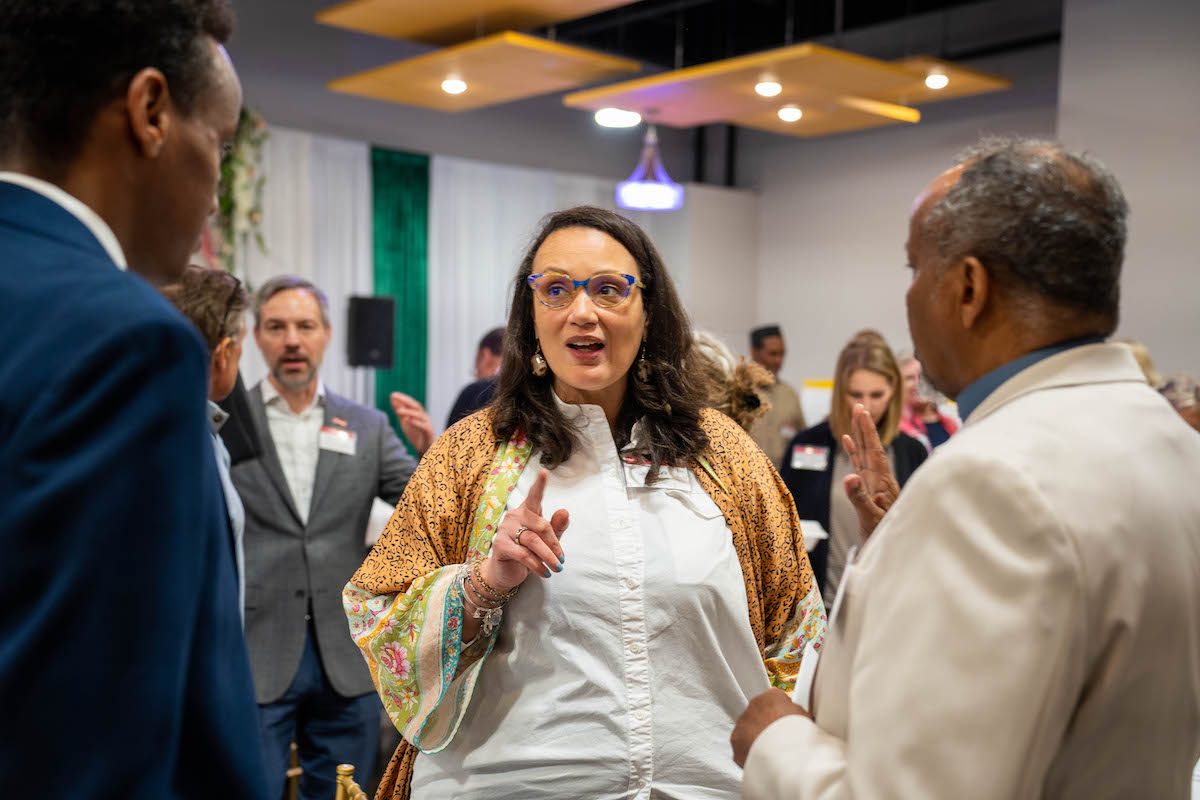ImpactAlpha, May 9 – Where do foundation presidents go to exchange their strategies for moving more capital to mission? The Mission Investors Exchange biennial conference.
The dozens of foundation presidents who will be in Chicago next week represent tens of billions in philanthropic capital. The co-chairs of the MIE conference are the Ford Foundation’s Darren Walker and MacArthur Foundation’s Julia Stasch. (See, “Mission Forward: Foundation leaders meet to talk place, race and impact” for a cheat sheet on some of the big names.)
“Mission Forward!” is the name for the sold-out conference, one of the few that highlights the particular role foundations play in the impact investing movement. ImpactAlpha is a media partner.
In advance of the conference, I exchanged email with Matt Onek, MIE’s CEO, to take the pulse of the field and get a preview of the conference, which runs May 14-16. Matt laid out the four big themes:
- Going Big. Experienced foundation practitioners tell us that the field is at an inflection point. Foundations are making much bigger commitments — in investment size, scope, and sophistication. There is focus on greater impact investing out of endowments.
- Driving Innovation. Foundations are developing innovative models to attract new investments to high-impact projects by providing more risk-tolerant, patient and flexible capital than other types of investors.
- Building Partnerships. The challenges facing our society and the planet are greater than any single institution or sector can solve. Foundations are mobilizing and collaborating, partnering and pooling resources for impact (and joining networks like Mission Investors Exchange).
- Championing Equity and Impact. “Mission Forward!” underscores the commitment to keep equity and impact at the heart of the impact investing movement. There has never been a greater need for philanthropy to focus on equity — in their impact investing, in their internal practices, and in the economy and society as a whole.
Other excerpts from our exchange:
David Bank, ImpactAlpha: What’s the buzz among foundations as you head to Chicago?
Matt Onek, Mission Investors Exchange: The imperative and the urgency for foundations to align more assets to mission couldn’t be greater right now, and foundations are deepening their impact investing practices at an impressive pace.
Foundations are leveraging their impact investing practices to address racial equity in innovative ways. The Entrepreneurs of Color Fund in Detroit, supported by W.K. Kellogg Foundation, Kresge Foundation, and other investors, nearly tripled in size last year, while also expanding to San Francisco and the South Bronx. The funds provide growth capital to minority-owned small businesses.
Powerful place-based impact investing collaborations are springing up across the country. These are dedicated to developing solutions to challenges in specific regions, from Benefit Chicago, to Minnesota Impact Investing Initiative, to the PhilaImpact Fund. This work is rapidly expanding across the country.
Foundations are deeply motivated to push the boundaries on their practices. We’ve seen bold commitments from our foundation members since the last conference. The Nathan Cummings Foundation just became the largest foundation to commit to aligning 100% of its endowment to mission. The Heron Foundation and Mary Reynolds Babcock Foundation recently reached the amazing goal of deploying 100% of their assets for impact. Ford Foundation has made some important investments on their way to fulfilling their $1 billion commitment to mission-related investing out of their endowment.
ImpactAlpha: Is the pace of foundation impact investing picking up?
Onek: The many examples of new commitments and greater deployment since our last conference are all great news. There is obviously still so much more work to do. Philanthropy is stepping up. More and more foundations are examining their investment practices, starting new impact investing programs, or significantly growing their existing efforts.
With more than 500 registrants, our Mission Investor Exchange conference sold out nearly a month in advance. Our members are using our platforms to share best practices and the latest investing tools. They want to know how to partner on deals and how to innovate through their investments and how best to mobilize more foundation capital for mission.
ImpactAlpha: ‘Place-based investing’ is breaking out all over. Why?
Onek: Place-based impact investing isn’t new. Community development organizations and community foundations have been leading this work for a long time. But the level of collaboration is becoming increasingly ambitious. With more voices seeking to participate and new tools for impact and collaboration, there is increasing awareness that impact investing needs to be done at a greater level of sophistication and scale to achieve the systemic changes our communities need.
Foundation capital can act as a catalyst to start and grow platforms to attract and channel additional investment into the local ecosystem. Benefit Chicago, for example, is a collaboration among the MacArthur Foundation, the Chicago Community Trust, and Calvert Impact Capital, that is mobilizing $100 million in impact investments for Chicago nonprofits and social enterprises through a community notes product designed to attract investments as small as $20.
With Benefit Chicago, MacArthur Foundation established and seeded the initial fund with $50 million, while the Chicago Community Trust and Calvert Impact Capital’s investment note served as the vehicle to raise an additional $50 million.
There are many more places around the country where foundations are collaborating with other investors to make progress around the issues that matter to them, and with solutions for their unique community needs. Without the support of the Bush Foundation and Otto Bremer Trust for an executive-in-residence, the Minnesota Impact Investing Initiative would not have been possible. Through the Initiative, foundations have co-invested millions so far in a fixed-income community investment product managed by RBC Global Asset Management.
Local impact investing ecosystems include diverse groups with different interests, knowledge and abilities. Foundations can take a leadership role in bringing these actors together and supporting their collaboration. We see that happening in Michigan and New Mexico, for instance, where foundation investments in ecosystem-building have catalyzed numerous place-based collaborations among these players.
ImpactAlpha: Is mobilizing endowment capital the next frontier?
Onek: Definitely. We have a session dedicated to how foundations are making major strategic shifts to engage more deeply in mission-related investing out of the endowment. That panel features leaders from Surdna Foundation, Mary Reynolds Babcock Foundation, California Wellness Foundation, The Russell Family Foundation, and the New Hampshire Charitable Foundation.
They will share their mission investing journeys with details on portfolio construction, deal sourcing, and impact measurement and management.
Foundations are increasingly re-envisioning how to deploy all their assets — including their endowments — for greater impact. Foundation impact investors bring a unique commitment to mission. This commitment means that they often look beyond individual deals to think about building markets and ensuring that ‘impact’ stays at the heart of the movement.











